RIVER HEALTH INDICATOR
PEOPLE
The health of our communities is directly tied to the health of the Potomac and our local lands and streams. One of the wildest urban rivers in the country, the Potomac is home to a diverse array of plants and wildlife and provides drinking water for over 5 million people.
Analyzing recreational use of the Potomac and how people connect with this treasured resource is important to understanding the accessibility and condition of our special outdoor places. When people engage with the river, they build an appreciation for natural places that provide clean water and benefit our quality of life. Paddlers, hikers, birders, anglers and everyone who enjoys the Potomac River experiences a connection to the water, which in turn, can deepen into a shared responsibility for protecting this valuable resource.

Public Access Points
Previous Grade: B+

State and local governments are working to improve access to the region's waterways. According to the EPA Chesapeake Bay Program, there are 287 public access points along the Potomac and its tributaries. Since the last report in 2018, twelve additional public access points were constructed in the watershed. The EPA’s 2014 Chesapeake Bay Watershed Agreement includes a goal to have 300 new sites in the Chesapeake Bay by 2025. By scaling from the bay-wide goal, the Potomac Conservancy has established a benchmark of 325 total public access sites in the Potomac River basin by 2025. As of 2018, the Potomac basin is 88 percent towards reaching the goal.
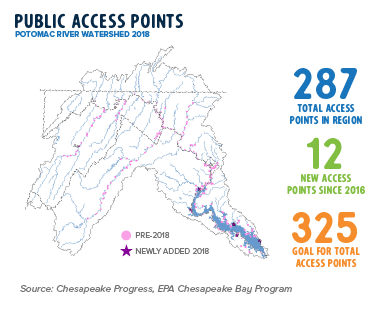
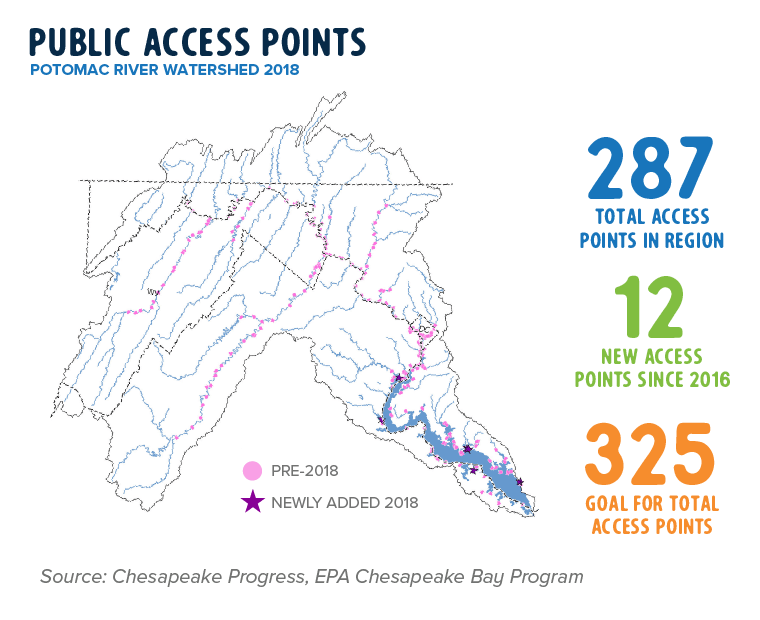

Sport Fishing Licenses
Previous Grade: C-

The Potomac is a valuable resource for commercial and recreational fishing.
Despite overall improved water conditions and fish species diversity, the number of sport fishing licenses issued for the tidal portion of the Potomac River has declined over the last five years, with a sharp decline from 2017 to 2018. The Potomac River Fisheries Commission (PRFC) regulates fishing in the tidal stretches of the Potomac River from Washington, DC down to the Chesapeake Bay. Potomac Conservancy set a target of 6,600 sport fishing license sales by 2025. In 2018, 1,656 (or 25% of the goal) individuals purchased a sport fishing license; the decline may be due to other factors such as above-average freshwater rainfall in 2018, pricing shifts, or regulatory changes.
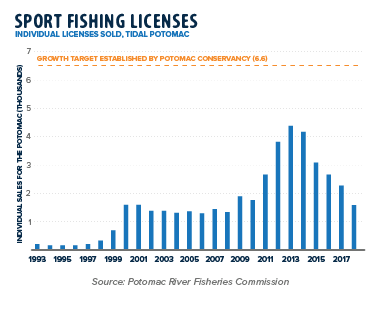
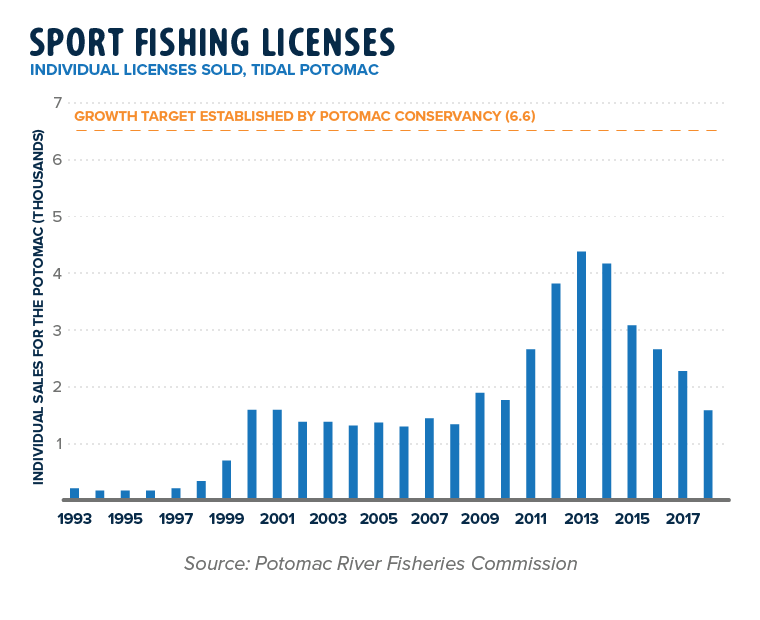

Outdoor Recreation
Previous Grade: B+

Outdoor recreation brings multiple benefits to residents and communities across the Potomac basin. Participating in outdoor activities strengthens individual connection with the river, fosters a stewardship ethic in our communities, promotes a healthy lifestyle, and boosts local and state economies. The latest report on outdoor consumer spending estimates $887 billion was spent nationally on outdoor recreation, which supports 7.8 million American jobs and generates $59.2 billion in state and local tax revenue. In Maryland, West Virginia and Virginia, outdoor recreation generates $2.8 billion in state and local tax revenue and directly employs 397,000 residents.
**These data were not updated since the 2018 Report Card.

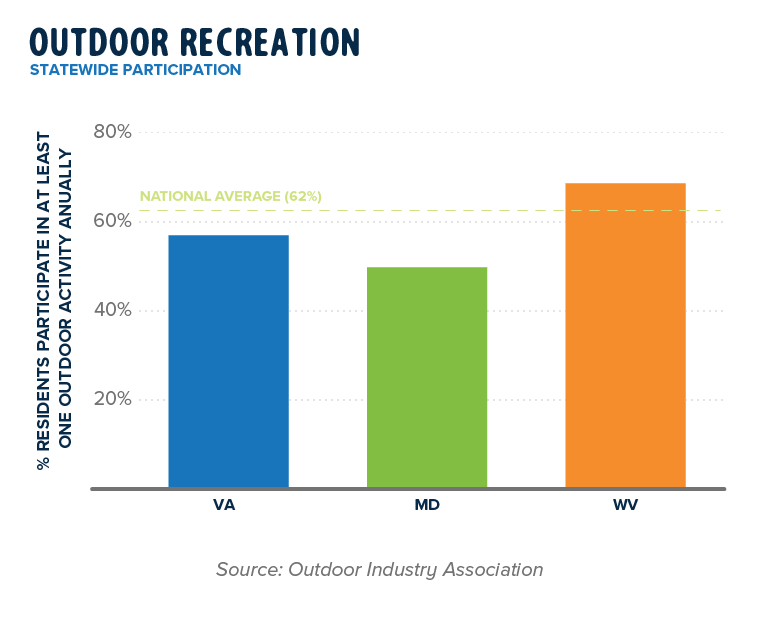

Park Visitation
Previous Grade: n/a

Visits to state and national parks in the Potomac River watershed decreased 10 percent to 7.7 million in 2018; however, outdoor recreation remains strong in our region. It’s possible the above-average rainfall experienced in the region in 2018 deterred visitors, but we cannot say with certainty. Park visitation data from 2020, which falls outside the scope of this report, suggests that overall interest in outdoor recreation has increased year-to-year, perhaps significantly, as people are turning to natural spaces for mental and physical well-being during the COVID-19 public health crisis. Lack of data related to specific river activities such as canoeing, kayaking, and fishing presents a challenge to understanding whether outdoor recreation along the river and in the watershed leads to increased awareness and river stewardship. There is no restoration target established for the Potomac River park visitation.
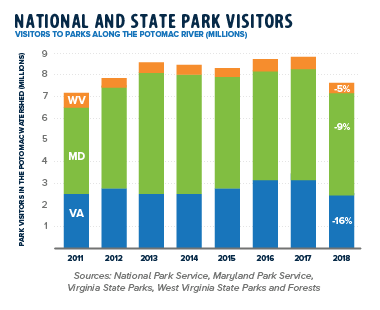
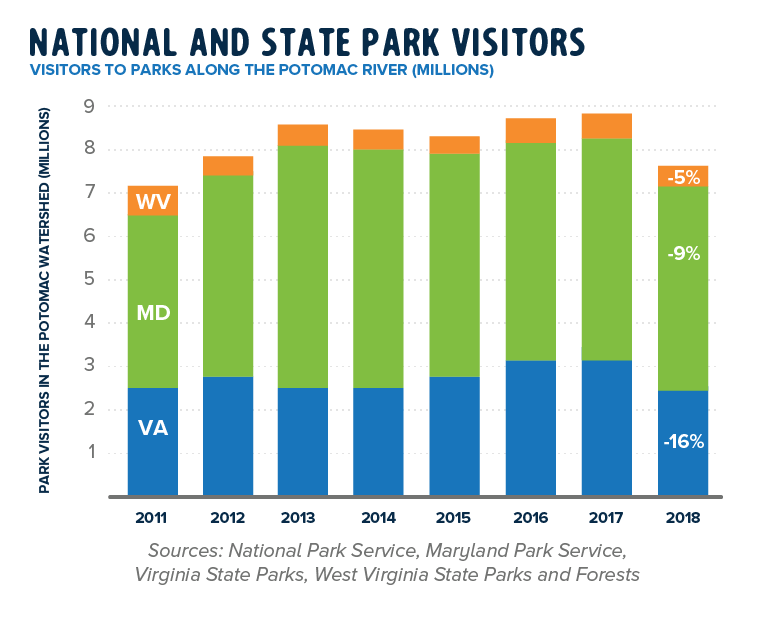
Resources and Methodology
This report uses individual sport fishing licensees as a metric from the Potomac River Fisheries Commission because it exemplifies the connection that individual sport fishing brings to the Potomac River. The tidal area regulated by the PRFC is representative of a larger Potomac watershed-wide metric, compared to other metrics that vary by jurisdiction. Public access points are measured and reported by the Chesapeake Bay Program. Recreational spending indicates how many private dollars are spent enjoying our outdoor resources. Finally, park visitation shows how the public is experiencing our public spaces.
Data for the People indicator are provided by the Chesapeake Bay Program, the U.S. Geological Survey, the Potomac River Fisheries Commission, the Outdoor Industry Association, the U.S. National Park Service, the Maryland Park Service, West Virginia State Parks, and Virginia State Parks.

 Habitat
Habitat Pollution
Pollution Fish
Fish Land
Land People
People Back to the River
Back to the River


 Printed
Printed Press
Press